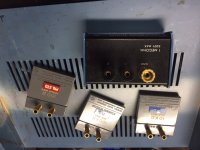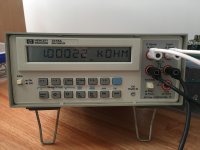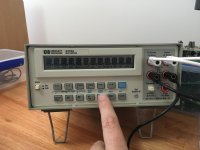I’m assuming HP sold these with leads
Leads were an option. Many of these were used in ATE (automated test equipment) stations where leads were not needed.
And here's the chart for an article I wrote in AX on Linear Tech's LTC1966, LTC1967 and LTC1968. (Sadly the LT1088 is obsolete!).
Are those measurements or from specs? I have two of those meters (the Fluke 8920 and the HP3403). I used to have an HP3456 but replaced it with a Fluke 8506A for its TRMS AC. It seems to use the same thermal converter thats in their current reference 792a. The scaling of the chart is a little odd for this stuff. Usually I see percent or dB which tend to be easier to use.
It just turned up today. It’s in really good condition. It’ll be a little while before I can really test it using the 3458A, but I’ve had a bit of a play measuring each of the functions and it looks plausible compared to my 87, which obviously won’t show gross errors.
Now to build some standards. I’m thinking of buying some Vishay 1ppm/degC 0.01% metal foil resistors, which go for ~$30 ea, which is doable.
For now it’s nice to be able to display 1.00143K with a 1K 1% resistor across the terminals.
Now to build some standards. I’m thinking of buying some Vishay 1ppm/degC 0.01% metal foil resistors, which go for ~$30 ea, which is doable.
For now it’s nice to be able to display 1.00143K with a 1K 1% resistor across the terminals.
Last edited:
For now it’s nice to be able to display 1.00143K with a 1K 1% resistor across the terminals.
You can borrow these if you promise to send them back -- Genrad and SRI resistance:
Attachments
Careful- that is quite the rabbit hole. Virtually every thread here Metrology - Page 1 is from an addict who thought he/she would just solve a little problem and move on.
I did not want to pay for calibration so I started accumulating the equipment. It seemed easy enough and it was all pretty cheap. but now with 2 7 dial KV dividers, 2 ratio transformers (LF and HF) and a Fluke 732A etc. along with an assortment of 6 1/2 digit meters and resistor/cap/inductor references I can now say I have zero confidence in anything I measure. Or my confidence is maybe 4 digits really.
Next weekend I'll have the 732A compared to another "known" reference so I'll know better what it is. Then it will take weeks to leverage that through all the other stuff.
Once you start understanding what is needed to get that accuracy you realize homebrew references will have limitations. However even the well aged references like those above will need periodic checking to confirm their stability.
I did not want to pay for calibration so I started accumulating the equipment. It seemed easy enough and it was all pretty cheap. but now with 2 7 dial KV dividers, 2 ratio transformers (LF and HF) and a Fluke 732A etc. along with an assortment of 6 1/2 digit meters and resistor/cap/inductor references I can now say I have zero confidence in anything I measure. Or my confidence is maybe 4 digits really.
Next weekend I'll have the 732A compared to another "known" reference so I'll know better what it is. Then it will take weeks to leverage that through all the other stuff.
Once you start understanding what is needed to get that accuracy you realize homebrew references will have limitations. However even the well aged references like those above will need periodic checking to confirm their stability.
A few year back, I was involved in some UL1029 testing of HID ballasts. We worked with UL to have them come in to witness the testing against our submitted reports. We were told by UL to use a Fluke 8846A, since it had data logging features that are required to measure the winding resistances of the core as it cooled after temp stabilization.
8846A is a great DMM/Dacq if you have the needs or budget for one.
8846A is a great DMM/Dacq if you have the needs or budget for one.
I have zero confidence in anything I measure. Or my confidence is maybe 4 digits really.
Here in the DIY audio world, what could possibly require more than 4 digits? Maybe plotting the linearity of a 16 bit or more DAC, but even there relative numbers are more important than absolute accuracy.
I come from a 41 year career at Motorola and the last 12 years I was in an advanced development group which turned into an IC design group for the last 5 or 6 years......yes, some of my work there did need a whole bunch of numbers after the decimal point, but we had the budget for it.
Here in the world of vacuum tube audio on a retiree's budget, 2 or 3 digits is plenty. Spend the money where it's really needed......and that does not include boutique parts either.
Tuning up a voltage controlled music synthesizer for the first time....OK, I'll fire up the 3478A.
The slightly dim, flickering LCD on my 3478A was bugging me a little, so I fixed it.
First I disassembled the meter. It's not obvious how it comes apart, but once you slide the case off backwards, you remove the screws holding the transformer, regulator, and a couple of grounds. Then disconnect the rear panel connectors (2 x BNC, GPIB, and four rear banana jacks).
Then there are four little tabs on the front that pry up, and the inner part of the front pushes out of the bezel along with the whole PCB. Once that's done remove the display from the rear of the front panel, pop the plastic clips holding the display glass to the PCB, remove the zebra strips, clean everything with cotton buds and isopropyl alcohol and reassemble. Take note of the orientation of the display glass, as it goes back in upside down just as easily as right way up.
While I was in there I gave the plastic cover in front of the display a bit of a polish (light blue polishing compound with a calico mop), as it had a bit of a mark that hadn't been able to clean off.
I'm very happy with the result. The display is much more legible now. Actually the whole instrument is looking quite nice.
First I disassembled the meter. It's not obvious how it comes apart, but once you slide the case off backwards, you remove the screws holding the transformer, regulator, and a couple of grounds. Then disconnect the rear panel connectors (2 x BNC, GPIB, and four rear banana jacks).
Then there are four little tabs on the front that pry up, and the inner part of the front pushes out of the bezel along with the whole PCB. Once that's done remove the display from the rear of the front panel, pop the plastic clips holding the display glass to the PCB, remove the zebra strips, clean everything with cotton buds and isopropyl alcohol and reassemble. Take note of the orientation of the display glass, as it goes back in upside down just as easily as right way up.
While I was in there I gave the plastic cover in front of the display a bit of a polish (light blue polishing compound with a calico mop), as it had a bit of a mark that hadn't been able to clean off.
I'm very happy with the result. The display is much more legible now. Actually the whole instrument is looking quite nice.
Attachments
Connected to a lab supply, with the 3458 also connected to compare the cal. The display on the 3458 updates quite quickly, but my phone camera freezes it nicely.
Not too shabby for a 30 year old calibration.
The only downside of putting it next to a new meter is that it makes it really obvious how yellowed it is.
Not too shabby for a 30 year old calibration.
The only downside of putting it next to a new meter is that it makes it really obvious how yellowed it is.
Attachments
-
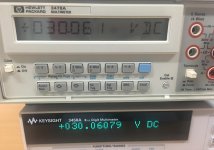 56CEF886-32B2-43DA-A0D1-8E52F80D69C8.jpg365.6 KB · Views: 132
56CEF886-32B2-43DA-A0D1-8E52F80D69C8.jpg365.6 KB · Views: 132 -
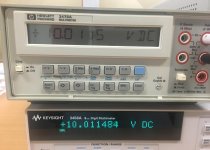 D8DE6E4C-33ED-471D-A5E1-B87ADDD0C275.jpg371.9 KB · Views: 126
D8DE6E4C-33ED-471D-A5E1-B87ADDD0C275.jpg371.9 KB · Views: 126 -
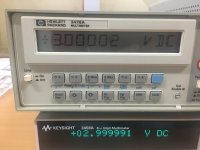 A5EEC8F5-87EF-47D1-8469-889D965D5863.jpg721.1 KB · Views: 127
A5EEC8F5-87EF-47D1-8469-889D965D5863.jpg721.1 KB · Views: 127 -
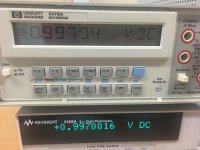 947CE884-DA1A-43BE-B1CB-706C852B01B1.jpg750 KB · Views: 99
947CE884-DA1A-43BE-B1CB-706C852B01B1.jpg750 KB · Views: 99 -
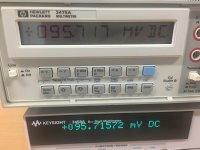 7904C2A6-6F0A-4586-A528-07C6CFBC9984.jpg745.3 KB · Views: 153
7904C2A6-6F0A-4586-A528-07C6CFBC9984.jpg745.3 KB · Views: 153 -
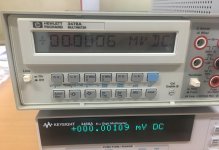 B19760E0-3C38-4F08-8445-449FFBB343F9.jpg356.2 KB · Views: 115
B19760E0-3C38-4F08-8445-449FFBB343F9.jpg356.2 KB · Views: 115
Last edited:
- Status
- This old topic is closed. If you want to reopen this topic, contact a moderator using the "Report Post" button.
- Home
- Design & Build
- Equipment & Tools
- Opinions on HP3478A meter
